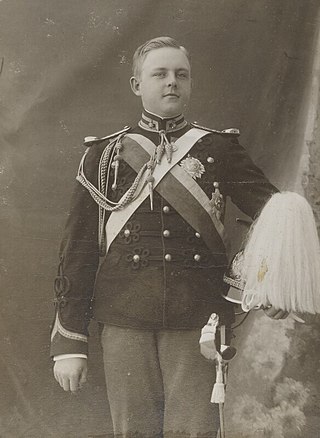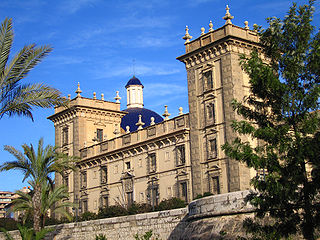
DomCarlos I, known as the Diplomat, the Martyr, and the Oceanographer, among many other names, was King of Portugal from 1889 until his assassination in 1908. He was the first Portuguese king to die a violent death since King Sebastian in 1578.

DomMiguel I, nicknamed "the Absolutist", "the Traditionalist" and "the Usurper", was the King of Portugal between 1828 and 1834. He was the seventh child and third son of King John VI and Queen Carlota Joaquina.

DomLuís Filipe, Prince Royal of Portugal, Duke of Braganza, was the eldest son and heir-apparent of King Carlos I of Portugal. He was born in 1887 when his father was still Prince Royal of Portugal and received the usual style of the heirs to the heir of the Portuguese crown: 4th Prince of Beira at birth, with the subsidiary title 14th Duke of Barcelos. After his grandfather King Luís I of Portugal died, he became Prince Royal of Portugal with the subsidiary titles 21st Duke of Braganza, 20th Marquis of Vila Viçosa, 28th count of Barcelos, 25th count of Ourém, 23rd count of Arraiolos and 22nd count of Neiva.

DomFerdinand II was a German prince of the House of Saxe-Coburg and Gotha-Koháry, and King of Portugal jure uxoris as the husband of Queen Maria II, from the birth of their first son in 1837 to her death in 1853.

The Calouste Gulbenkian Museum houses one of the world's most important private art collections. It includes works from Ancient Egypt to the early 20th century, spanning the arts of the Islamic World, China and Japan, as well as the French decorative arts, the jewellery of René Lalique and some of the most important painters of all times works such as Rembrandt, Monet, Rubens, Manet, Renoir, Degas and Turner.

Dom José, Prince of Brazil, Duke of Braganza was the heir apparent to the Kingdom of Portugal until his death in 1788, as the eldest child of Queen Dona Maria I of Portugal and King Dom Pedro III of Portugal, members of the House of Braganza.

Infante Dom Afonso of Braganza, Duke of Porto was a Portuguese Infante of the House of Braganza, the son of King Luis I of Portugal and his wife, Maria Pia of Savoy. From 1908 to the abolition of the Portuguese monarchy in 1910 he was the Prince Royal of Portugal as heir presumptive to his nephew, King Manuel II.

The Museu Nacional de Arte Antiga, also known in English as the National Museum of Ancient Art, is a Portuguese national art museum located in Lisbon. With over 40,000 items spanning a vast collection of painting, sculpture, goldware, furniture, textiles, ceramics, and prints, MNAA is one of the most visited museums in Portugal.

Jaime or James of Portugal, also known as James of Coimbra, James of Lusitania, was a Portuguese infante (prince) of the House of Aviz, and a bishop and cardinal of the Roman Catholic Church.

Gregório Lopes was one of the most important Renaissance painters from Portugal.

Josefa de Óbidos was a Spanish-born Portuguese painter. Her birth name was Josefa de Ayala Figueira, but she signed her work as "Josefa em Óbidos" or "Josefa de Ayalla". All of her work was executed in Portugal, her father's native country, where she lived from the age of four. Approximately 150 works of art have been attributed to Josefa de Óbidos, making her one of the most prolific Baroque artists in Portugal.
Garcia Fernandes was a Portuguese Renaissance painter. Like many of painters of the time, Garcia Fernandes was a pupil in the Lisbon workshop of Jorge Afonso, who was the court painter of King Manuel I.

The Grão Vasco Museum is an art museum located in the city of Viseu, in Portugal. The museum is named after one of the most important Portuguese painters of the Renaissance, Vasco Fernandes, who had his workshop in Viseu.

The church of Saint Anthony in Campo Marzio, known as Saint Anthony of the Portuguese, is a Baroque Roman Catholic titular church in Rome, dedicated to Saint Anthony of Lisbon. The church functions as a national church of the Portuguese community residing in that city and pilgrims visiting Rome and the Vatican. It also serves the Brazilian community.

Google Arts & Culture is an online platform of high-resolution images and videos of artworks and cultural artifacts from partner cultural organizations throughout the world.

The Museu de Belles Arts de València is an art gallery in Valencia, Spain, founded in 1913. It houses some 2,000 works, most dating from the 14th–17th centuries, including a Self portrait of Diego Velázquez, a St. John the Baptist by El Greco, Goya's Playing Children, Gonzalo Pérez's Altarpiece of Sts. Ursula, Martin and Antony and a Madonna with Writing Child and Bishop by the Italian Renaissance master Pinturicchio. It houses a large series of engravings by Giovan Battista Piranesi.

Peter V, nicknamed "the Hopeful", was King of Portugal from 1853 to 1861.

The Pantheon of the House of Braganza, also known as the Pantheon of the Braganzas, is the final resting place for many of the members of the House of Braganza, located in the Monastery of São Vicente de Fora in the Alfama district of Lisbon, Portugal. The pantheon's burials have included Portuguese monarchs, Brazilian monarchs, a Romanian monarch, queen consorts of Portugal, and notable Infantes of Portugal, among others.

Tiago Emanuel da Silva Miranda, known professionally as Conan Osíris, is a Portuguese singer-songwriter. His stage name is based on the main character from Japanese series Future Boy Conan and the ancient Egyptian god Osiris.

The Cardinal of Portugal's Altarpiece, or the Altarpiece for the Cardinal of Portugal's Chapel, is a painting of c. 1466 in tempera and oil on panel by one or both of the brothers Antonio and Piero del Pollaiuolo. It was painted for the altar in the Cardinal of Portugal's Chapel, a funerary chapel in the church of San Miniato al Monte in Florence, built for the prince and cardinal James of Portugal, who died in exile in Florence in 1459 at the age of 25.




















